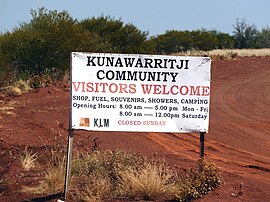Background
The Kunawarritji settlement (5 kilometres north-west of Well 33) was established in the early 1980s by a group of Martu people from Punmu. The current population is made up primarily of Martu people, consisting of approximately 115 people. As the community is of cultural significance to all Martu people in the western desert, the population can increase up to 1000 during cultural business.
Punmu and Parnngurr are the other large Western Desert communities situated 165 km and 230 km west of Kunawarritji respectively. The Kunawarritji community frequently interacts with these and other communities in the area.
Fuel (diesel and Opal) and a limited range of supplies are available from the store.
The Martu (Mardu) are a grouping of several Aboriginal Australian peoples in the Western Desert cultural bloc.
Jigalong is a remote Aboriginal community of approximately 333 people located in the Pilbara region of Western Australia.
Mulan is a small Aboriginal community in Western Australia's east Kimberley. The community is in the Shire of Halls Creek, 44 km to the southwest of Balgo and about 10 km east of Lake Gregory. At the 2006 census, Mulan had a population of 114.
Wakathuni is a small Aboriginal community, located 20 km south east of Tom Price in the Pilbara region of Western Australia, within the Shire of Ashburton.

Parnngurr is a medium-sized Aboriginal community, located 370 km from Newman in the Pilbara region of Western Australia, within the Shire of East Pilbara. Parnngurr was originally known as Cotton Creek, the name of the ephemeral creek that runs beside the community.

Punmu is an Aboriginal community, located 640 km south east of Port Hedland in the Pilbara region of Western Australia, within the Shire of East Pilbara.
Billiluna, also known as Mindibungu and Kururrungku, is a medium-sized Aboriginal community, located approximately 150 km (93 mi) south of Halls Creek in the Kimberley region of Western Australia, within the Shire of Halls Creek. In the 2016 census, Billiluna had a total population of 150 predominantly Aboriginal and Torres Strait Islander people.
Yulga Jinna is a medium-sized Aboriginal community located 130 km north of Meekatharra in the Mid-West region of Western Australia, within the Shire of Meekatharra.
Tjuntjuntjara is a large Aboriginal community located 650 km north east of Kalgoorlie in the Goldfields–Esperance region of Western Australia, within the Shire of Menzies in the southern part of the Great Victoria Desert.
Papulankutja is a large Aboriginal community located in the Goldfields–Esperance region of Western Australia, within the Shire of Ngaanyatjarraku.
Tjukurla is an Aboriginal community, located in the Goldfields-Esperance region of Western Australia, within the Shire of Ngaanyatjarraku.
Warakurna is a large Aboriginal community, located in the Goldfields-Esperance region of Western Australia, within the Shire of Ngaanyatjarraku and is situated on the Great Central Road. It is at the western end of the Rawlinson Ranges. At the 2016 census, Warakurna had a population of 268, including 237 who identified as Aboriginal Australians, most of whom speak Ngaanyatjarra at home.
Weymul is a small Aboriginal community, located 30 km south of Karratha in the Pilbara region of Western Australia, within the City of Karratha.
Mud Springs is a small Aboriginal community, located proximate to Kununurra in the Kimberley region of Western Australia, within the Shire of Wyndham-East Kimberley.
Four Mile is a small Aboriginal community, located proximate to Kununurra in the Kimberley region of Western Australia, within the Shire of Wyndham-East Kimberley.
Bell Springs is a small Aboriginal community, located proximate to Kununurra in the Kimberley region of Western Australia, within the Shire of Wyndham-East Kimberley.
Woolergerberleng is a small Aboriginal community, located proximate to Kununurra in the Kimberley region of Western Australia, within the Shire of Wyndham-East Kimberley.
Jimbilum is a small Aboriginal community, located proximate to Kununurra in the Kimberley region of Western Australia, within the Shire of Wyndham-East Kimberley.
Parnpajinya is a small Aboriginal community, located proximate to Newman in the Pilbara region of Western Australia, within the Shire of East Pilbara.
The Ngurrara and Ngururrpa are overlapping groupings of Aboriginal Australian peoples of the Great Sandy Desert, in the central Pilbara and southern Kimberley regions of Western Australia. Both groups are represented by various Aboriginal corporations which look after their native title interests.
This page is based on this
Wikipedia article Text is available under the
CC BY-SA 4.0 license; additional terms may apply.
Images, videos and audio are available under their respective licenses.


